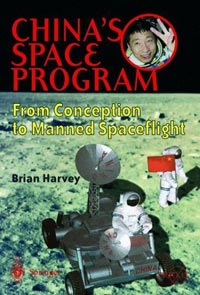Review: China’s Space Programby Jeff Foust
|
| China’s Space Program is perhaps the best single-volume summary of Chinese space efforts, at least among those written in English. |
China’s Space Program starts with a detailed narrative of the flight of Shenzhou 5, from the pre-launch preparations through the actual mission to the safe recovery of Yang Liwei. Harvey then provides a detailed history of Chinese space efforts, which began in earnest when the Chinese-born, American-educated scientist Tsien Hsue Shen returned to China in the 1950s, a victim of McCarthy-era persecution for alleged communist ties. Tsien and other Chinese engineers (many of whom were also graduates of American universities) embarked on a series of efforts to develop guided missiles and, later, satellite launch vehicles. This culminated in the successful launch of China’s first satellite, Dong Fang Hong (“East is Red”), in 1970.
Harvey’s book is not a strictly chronological account of the history of China’s space program: after examining the early history of China’s program, various chapters explore in detail satellite and launch vehicle development, China’s foray into the commercial launch market (and the technology transfer controversy with the US in the late 1990s that effectively shut down those efforts), the various organizations and facilities used by the program, and, of course, the development of a manned program, including an abortive attempt to develop human spaceflight capability in the early 1970s, just a few years after China launched its first satellite. Not surprisingly, a final chapter examines the future of China’s space program, including a potential space station and robotic (but not human) missions to the Moon and even Mars. (This makes the cover which purports to show a manned Chinese lunar mission, complete with a rover that prominently displays the word “China” in several places, a bit misleading.)
China’s Space Program is perhaps the best single-volume summary of Chinese space efforts, at least among those written in English. The book is thoroughly researched, with references at the end of each chapter and an extensive bibliography at the end. (Harvey appears to limit himself primarily to English-language sources for his research; it’s not clear how limiting the exclusion of Chinese-language sources is, given the tight control the government puts on the release of any information on the program.) The book contains many photos and illustrations from Chinese and Western sources. Unfortunately, some of them have the fuzzy, muddy look of low-resolution images pulled from the Web.
While published a year ago, China’s Space Program is still very relevant: the book is only missing some additional details about the Chang’e lunar exploration program and the upcoming Shenzhou 6 mission that have been revealed in the last 12 months. That makes this book just as timely as ever: with Shenzhou 6 to launch in the coming weeks, a book like this offers the reader a better perspective on China’s space program and helps to weed out the hype and hysteria that is sure to follow the mission in the media.
